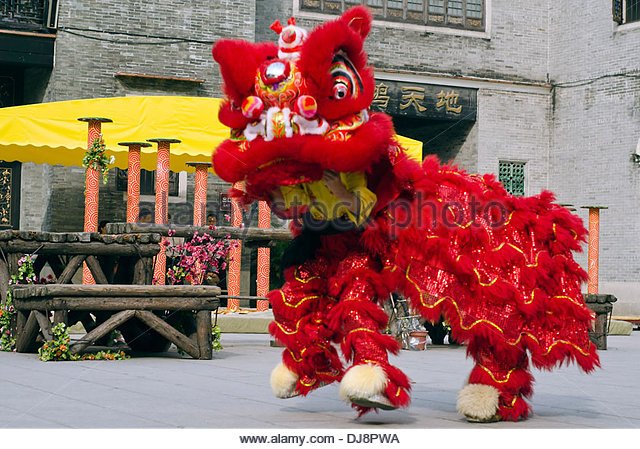China is an extremely large country, and the customs and traditions of its people vary by geography and ethnicity.
More than 1 billion people live in China, according to the Asia Society, representing 56 ethnic minority groups. The largest group is the Han Chinese, with about 900 million people. Other groups include the Tibetans, the Mongols, the Manchus, the Naxi, and the Hezhen, which is smallest group, with fewer than 2,000 people.
"Significantly, individuals within communities create their own culture," said Cristina De Rossi, an anthropologist at Barnet and Southgate College in London. Culture includes religion, food, style, language, marriage, music, morals and many other things that make up how a group acts and interacts. Here is a brief overview of some elements of the Chinese culture.
A dragon dance celebrates the temple at Foshan, China.

Religion
The Chinese Communist Party that rules the nation is officially atheist, though it is gradually becoming more tolerant of religions, according to the Council on Foreign Relations. Currently, there are only five official religions. Any religion other than Buddhism, Taoism, Islam, Catholicism and Protestantism are illegal, even though the Chinese constitution states that people are allowed freedom of religion. The gradual tolerance of religion has only started to progress in the past few decades.
About a quarter of the people practice Taoism and Confucianism and other traditional religions. There are also small numbers of Buddhists, Muslims and Christians. Although numerous Protestant and Catholic ministries have been active in the country since the early 19th century, they have made little progress in converting Chinese to these religions.
Language
There are seven major groups of dialects of the Chinese language, which each have their own variations, according to Mount Holyoke College. Mandarin dialects are spoken by 71.5 percent of the population, followed by Wu (8.5 percent), Yue (also called Cantonese; 5 percent), Xiang (4.8 percent), Min (4.1 percent), Hakka (3.7 percent) and Gan (2.4 percent).
Chinese dialects are very different, according to Jerry Norman, a former professor of linguistics at the University of Washington and author of "Chinese (Cambridge Language Surveys)" (Cambridge University Press, 1988). "Chinese is rather more like a language family than a single language made up of a number of regional forms," he wrote. "The Chinese dialectal complex is in many ways analogous to the Romance language family in Europe. To take an extreme example, there is probably as much difference between the dialects of Peking [Beijing] and Chaozhou as there is between Italian and French."
The official national language of China is Pŭtōnghuà, a type of Mandarin spoken in the capital Beijing, according to the Order of the President of the People's Republic of China. Many Chinese are also fluent in English.
Food
Like other aspects of Chinese life, cuisine is heavily influenced by geography and ethnic diversity. Among the main styles of Chinese cooking are Cantonese, which features stir-fried dishes, and Szechuan, which relies heavily on use of peanuts, sesame paste and ginger and is known for its spiciness.
Rice is not only a major food source in China; it is also a major element that helped grow their society, according to "Pathways to Asian Civilizations: Tracing the Origins and Spread of Rice and Rice Cultures," an 2011 article in the journal Rice by Dorian Q. Fuller. The Chinese word for rice is fan, which also means "meal," and it is a staple of their diet, as are bean sprouts, cabbage and scallions. Because they do not consume a lot of meat — occasionally pork or chicken — tofu is a main source of protein for the Chinese.
The Arts
Chinese art is greatly influenced by the country’s rich spiritual and mystical history. Many sculptures and paintings depict spiritual figures of Buddhism, according to the Metropolitan Museum of Art.
Many musical instruments are integral to Chinese culture, including the flute-like xun and the guqin, which is in the zither family.
Eastern-style martial arts were also developed in China, and it is the birthplace of kung fu. This fighting technique is based on animal movements and was created in the mid-1600s, according to Black Belt Magazine.
Ancient Chinese were avid writers and philosophers — especially during the Ming and Qing dynasties — and that is reflected in the country’s rich liturgical history.
Customs and celebrations
The largest festival — also called the Spring Festival — marks the beginning of the Lunar New Year. It falls between mid-January and mid-February and is a time to honor ancestors. During the 15-day celebration, the Chinese do something every day to welcome the new year, such as eat rice congee and mustard greens to cleanse the body, according to the University of Victoria. The holiday is marked with fireworks and parades featuring dancers dressed as dragons.
Many people make pilgrimages to Confucius' birthplace in Shandong Province on his birthday, Sept. 28. The birthday of Guanyin, the goddess of mercy, is observed by visiting Taoist temples. It falls between late March and late April. Similar celebrations mark the birthday of Mazu, the goddess of the sea (also known as Tianhou), in May or June. The Moon Festival is celebrated in September or October with fireworks, paper lanterns and moon gazing.
Hi! I am a robot. I just upvoted you! I found similar content that readers might be interested in:
https://www.livescience.com/28823-chinese-culture.html
Thank you for upvoted me.. Thanks a lot
Not indicating that the content you copy/paste is not your original work could be seen as plagiarism.
Some tips to share content and add value:
Repeated plagiarized posts are considered spam. Spam is discouraged by the community, and may result in action from the cheetah bot.
Creative Commons: If you are posting content under a Creative Commons license, please attribute and link according to the specific license. If you are posting content under CC0 or Public Domain please consider noting that at the end of your post.
If you are actually the original author, please do reply to let us know!
Thank You!